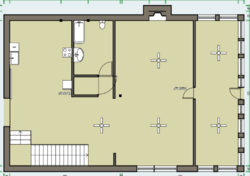I have looked through old post and spoken to a few co-workers on trying to get heat on my to my second floor.
I recently (1year ago) purchased a home with an old Timberline wood stove, i had the chimney cleaned by the previous owner and use the stove no problems last year. But i also have an oil furnace. Last year i re-filled 4 times my old during the winter season along with using the stove 24/7. I spoke to a few people i know and who use woodstoves but all of them have it installed in their basement and have a 1 floor home so heating that is a normally "easy"
This year i purchased a Droplet 1800i and replaced my the Timberland woodstove. My home is 2100 SQFt, and i am having the most difficult time heating my second floor from the woodstove,
My upstairs thermostat is set to 60 just to keep the wife and prevent our pipes from freezing. I would really like to use my wood stove to heat my home comfortably without to constantly fill my oil tanks.
I have seasoned wood thats just under 2 years old. The main room can easily get it to 75 degrees before we have to leave the room for a short period of time.
The stove was installed with a block off place and fresh air intake from the outside. Nothing more frustrating than sitting in the living room where the stove is at 75 degrees and then hearing the whole house shake as the furnace turns on right below the wood stove, i know cutting holes in the living room where the stove is installed, is most likely a code violation (havent checked yet) but what is the advice from all of you veterans who have been heating their homes with wood stoves.
I have included a layout of the home (first floor) to better assist in some input. What i have done is, put a small floor vortex fan at the top of the steps pointing on the similar angle as the stairs to "push" cold air down the stairs and then i put a box fan on low speed just like he top of the stairs to move the cold air coming from the top of the stairs towards the room where the stove is. Any assistance would be appreciated on this

I recently (1year ago) purchased a home with an old Timberline wood stove, i had the chimney cleaned by the previous owner and use the stove no problems last year. But i also have an oil furnace. Last year i re-filled 4 times my old during the winter season along with using the stove 24/7. I spoke to a few people i know and who use woodstoves but all of them have it installed in their basement and have a 1 floor home so heating that is a normally "easy"
This year i purchased a Droplet 1800i and replaced my the Timberland woodstove. My home is 2100 SQFt, and i am having the most difficult time heating my second floor from the woodstove,
My upstairs thermostat is set to 60 just to keep the wife and prevent our pipes from freezing. I would really like to use my wood stove to heat my home comfortably without to constantly fill my oil tanks.
I have seasoned wood thats just under 2 years old. The main room can easily get it to 75 degrees before we have to leave the room for a short period of time.
The stove was installed with a block off place and fresh air intake from the outside. Nothing more frustrating than sitting in the living room where the stove is at 75 degrees and then hearing the whole house shake as the furnace turns on right below the wood stove, i know cutting holes in the living room where the stove is installed, is most likely a code violation (havent checked yet) but what is the advice from all of you veterans who have been heating their homes with wood stoves.
I have included a layout of the home (first floor) to better assist in some input. What i have done is, put a small floor vortex fan at the top of the steps pointing on the similar angle as the stairs to "push" cold air down the stairs and then i put a box fan on low speed just like he top of the stairs to move the cold air coming from the top of the stairs towards the room where the stove is. Any assistance would be appreciated on this



 ) Using joist cavities as ducts without lining them with sheet metal/duct material is generally frowned upon so consider that. Worst case they may require you install fire sensing grates like those used in multi family structures... Not a bad idea even if its not required.
) Using joist cavities as ducts without lining them with sheet metal/duct material is generally frowned upon so consider that. Worst case they may require you install fire sensing grates like those used in multi family structures... Not a bad idea even if its not required.